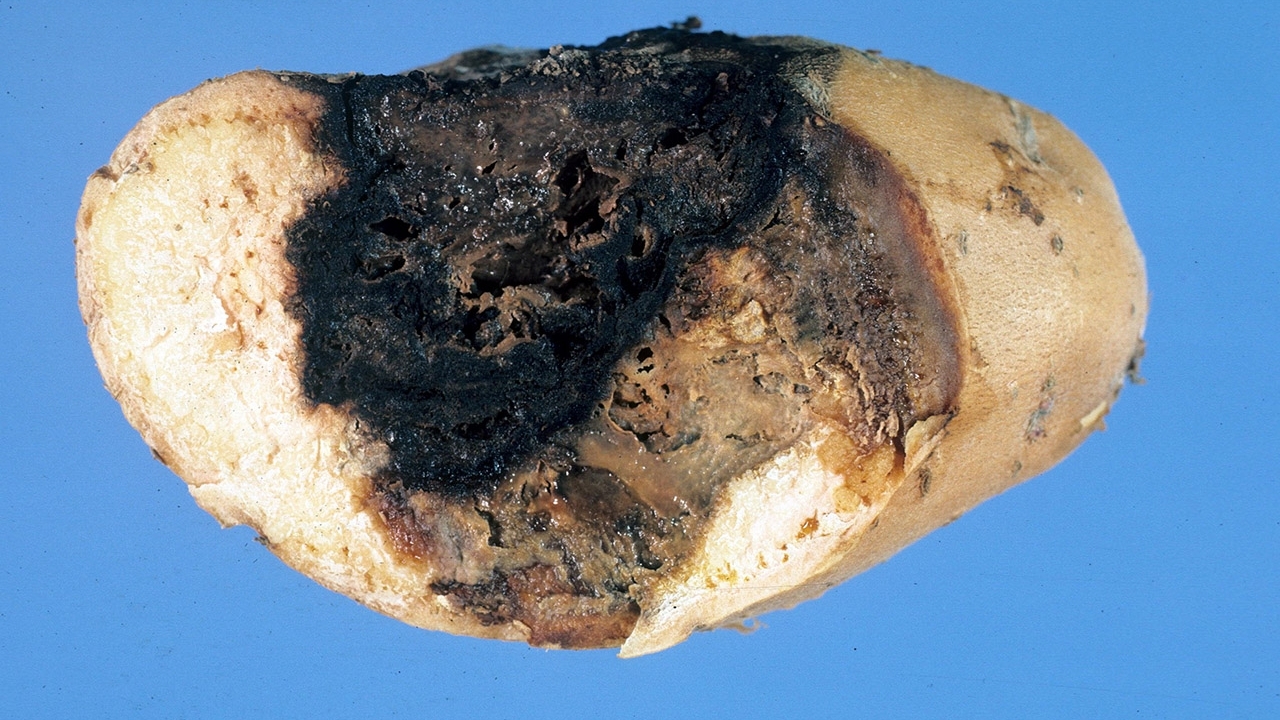Dickeya

Charles Averre, North Carolina State University, Bugwood.org
Dickeya are bacteria that cause disease on many types of ornamental plants and crops, including potato. The bacteria feed on plant roots, tubers, stems, and leaves, causing wilting and soft rot. There are 12 known Dickeya species.
In 2016, APHIS determined D. dianthicola is established in the United States. The more severe strains, including D. solani, are not known to occur in this country but have been detected in seed potatoes across Europe since 2004.
Dickeya infection symptoms often look like blackleg, a common plant disease caused by another bacteria, Pectobacterium. Under wet conditions, symptoms include slimy, black lesions starting below ground and spreading up the stem. In dry conditions, the symptoms are usually stunting, yellowing, wilting, and extreme dryness of the stem. Dickeya also causes soft rot in tubers (the thick, fleshy parts of stems found below ground).
Dickeya are more harmful than other bacteria that cause blackleg symptoms. They are more aggressive and spread more readily through the plant's vascular tissue. Dickeya species can cause disease to develop at higher temperatures than other blackleg pathogens.
Dickeya are primarily spread through infected seed or by using contaminated equipment. The bacteria can also spread in water or by insects. To reduce the risk of introducing or spreading the bacteria, wash and disinfect your equipment and tools before:
- Seed cutting
- Planting
- Spraying
- Harvesting
- Grading in fields
- Storing and grading
Preventing Blackleg in Potatoes
Below is general guidance to reduce the likelihood of blackleg in potatoes. Consult with local and university extension advisors for the most appropriate approach to prevent the occurrence or spread of blackleg in your area.
When Purchasing and Planting Seed
- Purchase certified seed potatoes from reputable sources.
- Request seed potato health certificates verifying they have been inspected, tested, and found to be disease-free.
- Examine tubers for any soft rot symptoms before planting.
- If possible, use whole seed. If using cut seed, properly disinfect your cutters.
- Plant tubers in well-drained soil after soil temperature is greater than 10 °C/50 °F.
During the Growing Season and Harvest
- Eliminate cull piles as they can harbor the bacteria. Don’t dispose of cull potatoes on fields that will be used for potato production.
- Scout potato fields for blackleg-diseased plants. Contact your local extension advisor at the first sign of symptomatic plants.
- If uncertain about the cause of disease in your field, sample the symptomatic plant or tuber, place in a clean plastic bag, and take to the university diagnostic laboratory or an extension advisor in your area.
- If the crop is irrigated, manage the system to prevent standing water in fields.
- Harvest potatoes after the vines are completely dead. This will limit wounding and reduce the risk of exposure to the bacteria.
- When possible, harvest potatoes under dry conditions.
- Minimize wounding and bruising by properly adjusting machinery during harvesting and grading.
- When possible, delay harvest until tuber pulp temperatures are between 45 °F and 65 °F.
- Use approved chemicals to clean and disinfect spraying, harvesting, and grading equipment. Follow a two-step process:
- Power wash or steam clean equipment to remove soil and debris before leaving the field site or take it to a nonfarm site for cleaning, AND
- Treat all surfaces with an approved disinfectant at labeled rates (read and follow all label directions). Keep surfaces wet for a minimum of 10 minutes. Some commonly used disinfectants include:
- Sodium, calcium, or ammonium hypochlorite
- Chlorine dioxide
- Copper quinolinolate
- Quaternary ammonium
- Hydrogen peroxide and/or peroxyacetic acid mixtures
- Plant crops in rotation by growing non-solanaceous crops the following year.
- Eliminate volunteer potatoes in rotation crops as they can be a source of infection for the next potato crop.
During Storage
- Clean and disinfect storage facilities and equipment before harvest.
- Consult with local extension advisors on proper storage recommendations for your area.
- If you suspect potato lots are infested with Dickeya, store those lots where they can be easily accessed and quickly removed if disease symptoms appear.
- After an initial 1- to 2-week period at 50-60 °F, lower the temperature to 38-42 °F for long-term storage.
Once plants are infected with Dickeya, there is no cure for the disease. It is important to plant fields with certified seed potatoes that have been tested and found free of the bacterium and to use best management practices to reduce the risk of spreading the disease.
Report Signs of Dickeya
Have you seen signs of Dickeya infection? Immediately report your findings. APHIS needs to positively identify the pathogen to determine if it's a regulated species of Dickeya.
Find your State plant regulatory official
Find your State plant health director
Controlling Dickeya
Dickeya Classifications
The table below describes the quarantine status for each Dickeya species. Non-quarantine means that APHIS will not take action for the specified area if a pathogen is detected at a port of entry.
(Table Updated July 2023)
| Dickeya Species | Dickeya Subspecies | USDA Quarantine Status in Agriculture Risk Management System* |
|---|---|---|
| D. aquatica | Quarantine for Mainland | |
| D. chrysanthemi | Non-Quarantine for Mainland | |
| D. dadantii | dadantii | Non-Quarantine for Mainland |
| D. dadantii | dieffenbachiae | Non-Quarantine for Mainland |
| D. dianthicola | Non-Quarantine for Mainland | |
| D. fangzhongdai | Quarantine for Mainland, Hawaii, and Puerto Rico | |
| D. lacustris | No data; no interceptions | |
| D. oryzae | No data; no interceptions | |
| D. paradisiaca | Quarantine for Mainland | |
| D. poaceiphila | No data; no interceptions | |
| D. solani | No data; no interceptions | |
| D. undicola | No data; no interceptions | |
| D. zeae | Non-Quarantine for Mainland |

